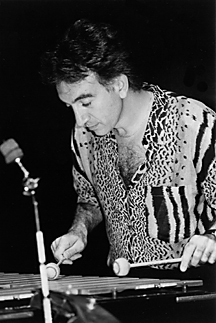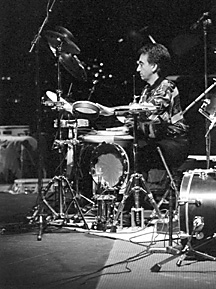The XXIst Century - Pulsing Times for Percussion
November 5, 2003
Version française...
Aldo Mazza
 The twentieth century was truly a century of innovation
for the percussion world. Whereas before, in western music, percussion served
mainly as accompaniment, percussion instruments were now placed front and centre
stage in ensemble, gaining their musical place along with string, brass and
other established ensemble players due to the development of performance
techniques and incredible advances in the making of the instruments. Some of
these advances include the evolution of the timpani's design and tuning
capacity. The twentieth century was truly a century of innovation
for the percussion world. Whereas before, in western music, percussion served
mainly as accompaniment, percussion instruments were now placed front and centre
stage in ensemble, gaining their musical place along with string, brass and
other established ensemble players due to the development of performance
techniques and incredible advances in the making of the instruments. Some of
these advances include the evolution of the timpani's design and tuning
capacity.
Technological advances in the timpani
In Mozart's day, two timpani were usually used with fixed notes since the
drums had no quick tuning mechanism. Later, chain mechanisms movable by hand
were developed which did facilitate tuning, but it was not until an actual pedal
mechanism was produced that the timpanist was able to have complete freedom in
tuning the drums. A player could then perform on five drums and tune them at
will. Germany was the leader in this domain, followed by the United States.
Naturally, as the making of the timpani evolved, so did performance standards
and compositional demands. A fine example of this is Igor Stravinsky's Rite
of Spring, one of many works which inspired more composers to write for timpani
for solo repertoire and for orchestral works.
Technological advances in cymbal making
The 1920s witnessed an
aggressive growth in the cymbal-making industry. Cymbal manufacturers worked
feverishly to produce new types of cymbals for orchestra and popular music. In
the United States, specifically, the evolution of jazz and drummers playing jazz
pushed cymbal design to new levels. Today, percussionists have thousands of
different cymbal types to choose from to satisfy the sound requirements of new
music creation and composers.
Technological advances in mallet instruments
The growth of tuned percussion instruments–xylophone, marimba, glockenspiel,
chimes, and vibraphone–was equally important in the last century. In fact, the
first time the xylophone was used in an orchestral setting was in Camille
Saint-Saens' Danse Macabre. After the invention of the vibraphone in America, the mallet
instrument development took off like lightning. Players and inventors such as
Deagan and Claire Musser not only created more than 20 types of instrument
design but also huge manufacturing plants. In 1915, the xylophone was the very
first instrument to be recorded by the RCA Company. In fact, the xylophone,
marimba and vibraphone became so wildly popular in those days that it was
rumoured that more American homes had mallet instruments than pianos. By the
1930s, mallet ensemble groups were touring the U.S. Claire Musser, himself a
player, inventor and composer, toured the U.S and Europe with a 100-piece
marimba orchestra, even playing at New York's famed Carnegie Hall. As audiences
grew accustomed to mallet ensembles, the players pushed performances to new
heights with novel techniques. Originally, great players such as Lionel Hampton,
Harry Breuer, Milt Jackson, and George Hamilton Greene used only two mallets. By
the 1960s, more contemporary performers, such as Gary Burton, Keiko Abe, Leigh
Howard Stevens, and Mike Mainieri, moved on to developing incredible four-mallet
performance. We now have musicians capable of using up to six mallets, and
composers are helping them push the envelope of performance capability on these
instruments.
The Influence of Jazz in the Development of the Drums 
Jazz music greatly influenced
the development of drums into what is now known as the standard "drum set".
There is also a parallel in their development from the great "pit" drummers
whose role was to create sounds for the silent movies of the day. One of the
early important twentieth century inventions for drums was the bass drum pedal.
This enabled a player to play snare drum and bass drum simultaneously. Next came
the invention of the high hat pedal (or low boy as it was originally called).
Now a player could play three parts – snare, bass drum and hand crash cymbals at
the same time. These inventions set the stage for the evolution of high-level
drumset performance as seen in today's jazz, rock, fusion and popular music
worlds.
The Development of Synthetic Skins
The invention of plastic drum
skins in the late 1950s, replacing traditional cowhide skins, changed the drum
world forever. Real skins, though they had great sound, were very difficult
during performance because of climate changes, which caused tuning problems.
This was eliminated with the advent of plastic drum skins.
Electronic music and computers
Throughout the twentieth century, we witnessed another element of great
importance, that of electronic music and computers. In 1907 Busoni wrote his
Sketches for a New Aesthetic of Music, directed at new sound sources for future
music. This new train of thought influenced many composers of the day, including
Edgard Varese, who turned to the new materials to compose and mix electronic
along with acoustic elements. It was the liberation of sound. The development of
amplifiers helped this new manipulation of sound as compositional material. Many
composers such as Stockhausen and Berio were responsible for furthering this
arena.
The 1960s saw the development of the large mainframe computer and
synthesizer, which led to the creation of such notable works as Switched-on
Bach. The 1980s
resounded to the coming out of midi (Musical Instrument Digital Interface) and
affordable synthesizers. All these developments greatly affected not only
composers but also percussionists, whonow need to know how to program and
perform with computers and pre-recorded tracks as well as create soundscapes
with samplers and physical modelling technology.
The Consequences of Growth for the 21st Century
Parallel to these massive changes in instrument making, and without a doubt
because of these huge technological advances and new possibilities, the
percussion world in the 21st century has become the new medium
of choice for some of the great composers of our time. Many, such as Varese,
Cage, Stockhausen, Xenakis, put percussion at the forefront. This inspired
percussion ensembles, dedicated to performing the new repertoire that finally
existed for percussion instruments, to expose audiences to this new music by
performing around the world and releasing recordings as a means of making a
living. Ensembles such as Les Percussions de Strassbourg, Répercussion, and
Black Earth Percussion Group, to name but a few, are dedicated to performing
solely music for percussion. The new vast repertoire available to these
ensembles includes not only electronic and experimental music (e.g. Harry
Parch), but increasingly composers are looking to non-western cultures for
materials to draw from--from Africa to Bali. Most of these non-western cultures
naturally relied on percussion in their traditional music. Thus, ironically,
modern western percussion developed further by using materials from
old traditional non-western music. This new marriage coined the term
"world music" as composers such as Xenakis wrote works for African djembes.
Today, in order to perform this "new" world music, the percussionist needs to be
proficient on timpani, congas, tamborinello (South Italian drum), drum set,
marimba, and African djembes. While percussionists can certainly specialize in
one of these instruments, it is clear that the percussionist of the twenty-first
century has to be comfortable with the music, instruments and techniques of
varied cultures. This is where the compositional future of percussion
lies -- and if you ask me -- it is truly an exciting time for
percussion!
Version française... |
|


